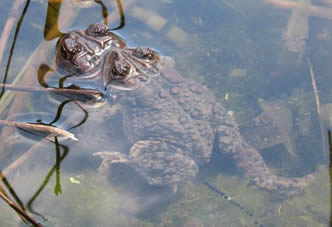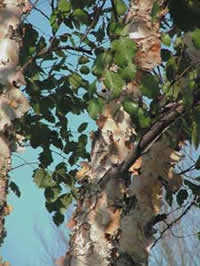Greetings!
Our next meeting is about Life in a Forest Puddle We're pleased to again have Interpretive Naturalist Jim D'Angelo join us. This year, he'll help us explore the life of vernal
pools. Vernal pools are small wetlands that temporarily fill with water
providing essential habitat for a diverse group of wildlife including
insects, frogs, salamanders, turtles and even a few snakes!!! We will
explore these unique wetlands the wildlife that utilize them, why we
should care and the threats that endanger them.
WHEN: Sunday April 25 at 2:00 pm
WHERE: Le Moyne College Library Special Activity Room (Directions)
Our meetings are free and open to the public. Come and bring a friend!
Toads mating (note string of black eggs)  | And if you want to learn more about growing fruits and vegetables, check out the Edible Gardening CNY meetings, too - also free and open to the public.
Janet Allen, President
Habitat Gardening in Central New York
|
|
Tree profile: River birch
River birch
(National Park Service photo)  | Our native birch trees are very beneficial for wildlife (it's one of Tallamy's top ten), and with their colorful bark, they're a wonderful addition to our home landscapes, too.
Although most people think of flowers as being important to butterflies, trees such as the birch are also important as places for them to raise their young. The caterpillars of butterflies such as white admiral and mourning cloak, and moths such as the spectacular cecropia moth feed on birch leaves.
Birds such as chickadees, kinglets, and juncos eat the seeds, and the tree also provides good nesting sites.
Unlike the white birches, the river birch (Betula nigra) is resistant to birch borer. River birches do well in our home landscapes, and it has particularly beautiful bark.
The river birch grows in light shade to sun and likes moist to moderately dry, acidic soil. It's a fast-growing tree that can reach 60-80 feet with a width of 15-25 feet.
It's most widely available as the cultivar "Heritage," though as William Cullina points out, "I worry that excessive use of this one clone will lead to some disease epidemic, a fate that seems to befall all monocultures in time."
|
|
When will they arrive?
It's hard to be patient as we await the arrival of our hummingbirds and monarch butterflies. One way to get a heads-up is to check the Journey North website. It maps the progress of both the ruby-throated hummingbirds and the monarch butterflies. Journey North also has a wealth of other information about these species from top scientists. (This site is designed to be especially useful for teachers to use in the classroom, too.)
Another site to check for the hummingbird migration is at Hummingbirds.net. This source also has other interesting information about hummingbirds.
Both sources show hummingbirds having already arrived to the east and to the west of us. They always seem to take a little longer to get to the Syracuse area for some reason.
If you want to provide nectar for the early birds, the recipe is 1 part table sugar to 4 parts water. Boil the water, then cool and serve. It will keep a week in the refrigerator.
Do NOT use honey, artificial sweeteners, or red food coloring, and don't locate it in the sun. Be sure to clean the feeder every few days. More information about feeding hummingbirds is at the Cornell Lab of Ornithology website.
All in all, for most of the season, it's easier to provide the native nectar plants you don't have to clean yourself!
Nectar ingredients
 |
|